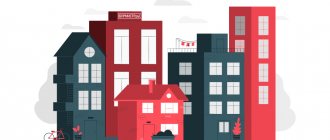1. Residential premises include: 1) a residential building, part of a residential building; 2) apartment, part of an apartment; 3) room.
2. A residential building is recognized as an individually defined building, which consists of rooms, as well as premises for auxiliary use, intended to satisfy citizens’ household and other needs related to their residence in such a building.
3. An apartment is recognized as a structurally separate room in an apartment building, providing direct access to the common areas in such a house and consisting of one or more rooms, as well as premises for auxiliary use, intended to satisfy citizens’ household and other needs related to their residence in such a separate room.
4. A room is recognized as a part of a residential building or apartment intended for use as a place of direct residence of citizens in a residential building or apartment.
Commentary on Article 16 of the RF Housing Code
1. The commented article reproduces the norm of Art. 673 of the Civil Code of the Russian Federation, which defines residential premises as an apartment, residential building, part of an apartment or residential building. Moreover, in both civil and housing legislation, a “residential building” is understood as a single-apartment building. When this concept refers to an apartment building, this is specifically indicated (clause 2 of Article 673 of the Civil Code of the Russian Federation, as well as Chapter 6 of the Housing Code of the Russian Federation).
2. Unlike the Housing Code of the Civil Code of the Russian Federation, it does not call a room an independent object of housing rights. And it is right. It is quite obvious that the part of the apartment as an object of housing relations (an isolated room suitable for permanent residence) means only a room. The remaining parts of the apartment are auxiliary premises (kitchen, bathroom, etc.).
3. It should be noted that the use of the general concept of “residential premises” for a residential building, part of a house, apartment, part of an apartment, room has certain disadvantages in relation to the object of housing relations. The apartment and room, along with auxiliary premises, form parts of a single whole - a residential building.
Section I. General provisions. Chapter 2. Objects of housing rights. Housing fund (Articles 15-21)
Section I. General provisions. Chapter 2. Objects of housing rights. Housing fund (Articles 15-21)
Article 15. Objects of housing rights
- The objects of housing rights are residential premises.
- Residential premises are recognized as isolated premises, which are real estate and are suitable for permanent residence of citizens (meets established sanitary and technical rules and regulations, and other legal requirements (hereinafter referred to as requirements).
- The procedure for recognizing premises as residential premises and the requirements that residential premises must meet are established by the Government of the Russian Federation in accordance with this Code and other federal laws.
- Residential premises may be declared unfit for habitation on the grounds and in the manner established by the Government of the Russian Federation.
- The total area of a residential premises consists of the sum of the area of all parts of such premises, including the area of auxiliary premises intended to satisfy citizens' household and other needs related to their residence in residential premises, with the exception of balconies, loggias, verandas and terraces.
Article 16. Types of residential premises 1) Residential premises include:
- residential building, part of a residential building;
- apartment, part of an apartment;
- room.
2) A residential building is recognized as an individually defined building, which consists of rooms, as well as premises for auxiliary use, intended to satisfy citizens’ household and other needs related to their residence in such a building.
3) An apartment is recognized as a structurally separate room in an apartment building, providing direct access to the common areas in such a house and consisting of one or more rooms, as well as premises for auxiliary use, intended to satisfy citizens’ household and other needs related to their residence in such a separate room.
4) A room is recognized as a part of a residential building or apartment intended for use as a place of direct residence of citizens in a residential building or apartment.
Article 17. Purpose of residential premises and limits of its use. Use of residential premises
- Residential premises are intended for the residence of citizens.
- It is permitted to use residential premises for professional activities or individual entrepreneurial activities by citizens legally residing there, if this does not violate the rights and legitimate interests of other citizens, as well as the requirements that the residential premises must meet.
- The placement of industrial production in residential premises is not allowed.
- The use of residential premises is carried out taking into account the rights and legitimate interests of citizens and neighbors living in this residential premises, fire safety requirements, sanitary, hygienic, environmental and other legal requirements, as well as in accordance with the rules for the use of residential premises approved by the Government of the Russian Federation.
Article 18. State registration of rights to residential premises
The right of ownership and other proprietary rights to residential premises are subject to state registration in cases provided for by the Civil Code of the Russian Federation, the federal law on the registration of rights to real estate and transactions with it, this Code.
Article 19. Housing stock
1) Housing stock - the totality of all residential premises located on the territory of the Russian Federation.
2) Depending on the form of ownership, the housing stock is divided into:
- private housing stock - a set of residential premises owned by citizens and owned by legal entities;
- state housing stock - a set of residential premises owned by the Russian Federation (housing stock of the Russian Federation), and residential premises owned by constituent entities of the Russian Federation (housing stock of the constituent entities of the Russian Federation);
- municipal housing stock - a set of residential premises owned by municipalities.
3) Depending on the purposes of use, the housing stock is divided into:
- housing stock for social use - a set of residential premises of state and municipal housing stock provided to citizens under social tenancy agreements;
- specialized housing stock - a set of residential premises of state and municipal housing funds intended for residence of certain categories of citizens and provided according to the rules of Section IV of this Code;
- individual housing stock - a set of residential premises of a private housing stock, which are used by citizens - owners of such premises for their residence, residence of members of their family and (or) residence of other citizens on the basis of free use, as well as legal entities - owners of such premises for the residence of citizens on specified terms of use;
- housing stock for commercial use - a set of residential premises that are used by the owners of such premises for the residence of citizens on the terms of paid use, provided to citizens under other agreements, provided by the owners of such premises to persons for possession and (or) use.
4) The housing stock is subject to state registration in the manner established by the Government of the Russian Federation.
5) State accounting of the housing stock, along with other forms of its accounting, should provide for technical accounting of the housing stock, including its technical inventory and technical certification (with the preparation of technical passports of residential premises - documents containing technical and other information about residential premises related to ensuring compliance of residential premises with established requirements).
Article 20. State control over the use and safety of the housing stock, compliance of residential premises with established requirements
State control over the use and safety of the housing stock, regardless of its form of ownership, as well as the compliance of residential premises and utilities with established requirements, is carried out by authorized federal executive authorities, state authorities of the constituent entities of the Russian Federation in accordance with federal law and other regulatory legal acts of the Russian Federation.
Article 21. Insurance of residential premises
In order to guarantee compensation for losses associated with loss (destruction) or damage to residential premises, residential premises may be insured in accordance with the law.
Another comment on Article 16 of the RF Housing Code
1. Meaning of comment. Art. consists of fixing a complete list of types of residential premises. In the above list, each preceding type relates to the subsequent one as a whole and its part, i.e. a room can be part of an apartment or a house, an apartment can be part of a residential building. Thus, premises in industrial buildings, barracks and non-permanent buildings cannot be objects of housing rights. At the same time, however, the Housing Code of the Russian Federation establishes the types of residential premises of specialized housing stock, which are intended for limited use in cases established by law (Article 92 of the Housing Code of the Russian Federation).
2. In parts 2, 3, 4 comments. Art. definitions of each type of residential premises are provided, which, taking into account the provisions of Art. 15 of the RF Housing Code make it possible to distinguish them from other objects of civil rights. First of all, residential premises are an individually defined thing, since we are talking about specific real estate. This thing (with the exception of the room) belongs to the category of complex things, including rooms and some other premises that have a mandatory functional purpose, i.e. suitable for permanent residence of citizens and satisfaction of household and other needs associated with living in them. Premises for auxiliary use (gazebos, garages, sheds, cellars, etc.), separated from a residential building or apartment, do not belong to residential premises.
A room can act as an independent object of housing rights only if it is isolated, although this property of this type of living space is discussed in the comments. Art. not mentioned.
Often, residential premises (apartments, rooms) are located in mixed-type buildings, which also contain premises used for medical institutions, offices, shops, etc. Apparently, the classification of such buildings into the category of residential (apartment) buildings depends, among other things, on what proportion of them is occupied by residential premises; as suggested in the legal literature, this share should be at least half of the total area of the building.
Concept and types of residential premises
For housing law, the concept of “residential premises” is of great importance, the definition of which is important for the correct application of laws and other regulations governing housing relations.
Living space
- this is an isolated room suitable for permanent residence of citizens, i.e. meeting established sanitary and technical rules and regulations, as well as other legal requirements.
The concept of “residential premises” is used in legislation in various senses:
A) as a generic concept, covering all types of residential premises (apartments, residential buildings, etc.), which may be the object of a residential rental agreement (see, for example, Article 673 of the Civil Code of the Russian Federation);
B) to designate part of a residential building (apartment, room in an apartment building).
Residential premises in the first broader sense are indicated by the legislator as objects of housing rights and are divided into types.
In accordance with the Housing Code of the Russian Federation (hereinafter referred to as the Housing Code of the Russian Federation), the following types of residential premises are distinguished:
1. A residential building is an individually defined building, which consists of rooms, as well as premises for auxiliary use, intended to satisfy citizens’ household and other needs related to their residence in such a building. From a legal point of view, a building is a residential building from the moment the construction of the house is completed, it is accepted into operation by the acceptance committee and registered in the prescribed manner as a residential building by authorized special organizations that carry out state accounting of the housing stock.
2. An apartment is a structurally separate room in an apartment building, providing direct access to common areas in such a house and consisting of one or more rooms, as well as auxiliary premises intended to satisfy citizens’ household and other needs related to their residence in such a separate room.
3. A room is a part of a residential building or apartment that is intended for use as a place of direct residence for citizens in a residential building or apartment.
Among the houses there are buildings of a mixed type, in which, along with residential premises, there are also non-residential premises: administrative, medical, communal, etc. Residential premises located in such houses are part of the housing stock.
To characterize a living space, it is important to allocate the total (useful) and living space inside the room. According to Art. 15 of the RF Housing Code, the total area of a residential premises consists of the sum of the area of all parts of such premises, including the area of auxiliary premises intended to satisfy citizens' household and other needs related to their residence in residential premises, with the exception of balconies, loggias, verandas and terraces. The living area includes only the area of all living rooms, including the area of bedrooms and dining rooms, rooms for games, study and recreation.
The definition of the concept of “residential premises” is important for resolving the issue of the subject of the residential lease agreement. According to paragraph 1 of Art. 673 Civil Code of the Russian Federation and Art. 62 of the Housing Code of the Russian Federation, such an object can only be an isolated residential premises suitable for permanent residence (apartment, residential building, part of a residential building or apartment). Non-isolated residential premises, premises for auxiliary use, as well as common property in an apartment building cannot be an independent subject of a social tenancy agreement (Part 2 of Article 62 of the Housing Code of the Russian Federation).
Based on the norm of Part 1 of Art. 19 of the Housing Code of the Russian Federation, the housing stock includes not only residential premises intended for permanent residence, but in general all premises suitable for living located on the territory of the Russian Federation. Accordingly, residential premises can be divided into two types:
1. Intended for permanent residence, i.e. designed for a long period of use;
2. Temporary in nature, which must be used by persons living in them for a limited period of time.
The main object of housing relations is permanent residential premises. This type of residential premises makes up the majority of premises included in the housing stock. At the same time, some residential premises are intended for temporary use as such, for example, residential premises in dormitories, flexible housing, hotels, office residential premises, etc.
In practice, the question often arises whether premises (buildings) such as prefabricated houses, change houses, carriages, etc. should be classified as residential premises. Currently, such structures and buildings are not included in the housing stock.
When deciding whether to classify residential premises as suitable for living, the degree of physical deterioration of the building (premises), the safety of its structures, the location of the building, the level of improvement, etc. are taken into account.
In terms of their functional purpose, the largest part of the municipal housing stock consists of residential premises provided under social tenancy agreements. These include residential buildings, apartments, rooms in communal apartments and other residential premises provided within the limits of living space.
Legal department
housing and communal services committee
farms in Barnaul




